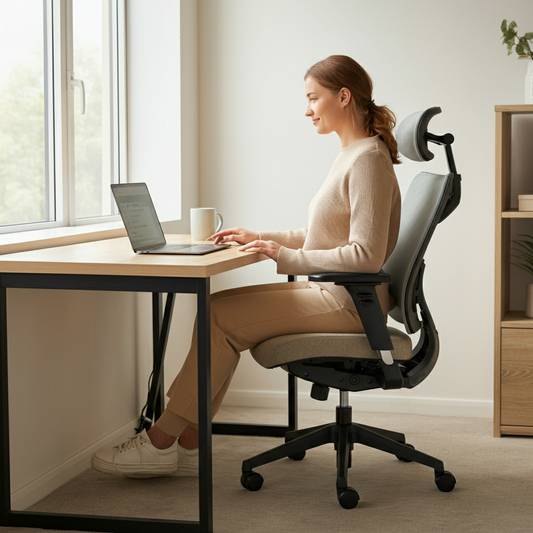Sitting for long hours doesn’t have to mean suffering from back or neck pain. An ergonomic chair is your first line of defence against poor posture and discomfort. However, even the best ergonomic chair won’t support your body correctly unless it’s adjusted properly. This guide will walk you through the steps to set up your ergonomic chair for optimal posture and maximum comfort.
By following this guide, you’ll learn how proper chair adjustments can prevent aches and pains while enhancing your productivity. We’ll also highlight Lundia’s exceptional range of ergonomic desk chairs, providing examples of adjustable and supportive options to suit all needs.
Importance of Setting Up Your Ergonomic Chair Correctly
An ergonomic chair is designed to support your body’s natural alignment. But if your chair isn’t set up correctly, you could still face issues such as:
- Chronic back or neck pain
- Poor circulation due to pressure on your legs
- Increased risk of musculoskeletal disorders
Knowing how to adjust an ergonomic chair for posture is critical in creating a comfortable workspace. Follow these steps to ensure you’re getting the full benefit of your ergonomic office chair.
Step-by-Step Guide to Adjusting Your Ergonomic Chair
1. Adjust the Seat Height
The correct seat height allows your feet to rest flat on the floor, which promotes proper blood flow and reduces strain on your legs and lower back.
- Step-by-step:
-
- Sit with your feet flat on the floor.
- Adjust the height so that your knees are at a 90-degree angle.
- Keep your thighs parallel to the floor, with a small gap between the seat and the back of your knees.
Lundia’s PostureMax Office Chair offers easy-to-use height adjustment levers to ensure perfect positioning for users of all sizes.
2. Position the Lumbar Support
The lumbar area of your spine naturally curves inward. A supportive ergonomic lumbar support chair ensures this curve is maintained, preventing slouching that can lead to back pain.
- Step-by-step:
-
- Locate the lumbar support feature on your chair.
- Adjust the depth and height so it fits snugly into the curve of your lower back.
- Ensure that it doesn’t feel forced but provides gentle support throughout the day.
Try Lundia’s ErgoActive Mesh Chair, which features an adjustable lumbar support designed for all-day comfort.
3. Set the Seat Depth
Seat depth adjustment ensures that the chair supports most of your thighs without pressing against the back of your knees.
- Step-by-step:
-
- Sit back so your spine is aligned with the backrest.
- Adjust the seat depth forward or backward so there’s about 2-3 fingers’ width between the seat edge and the back of your knees.
Lundia’s chairs like the Classic Comfort Chair offer adaptable seat depth settings to suit users of varying heights.
4. Adjust the Armrest Height and Position
Armrests aren't just for resting your arms—they help keep your shoulders relaxed and your arms supported, reducing tension in your neck and shoulders.
- Step-by-step:
-
- Sit with your elbows at a 90-degree angle, close to your sides.
- Adjust the armrest height to match this angle, so your arms feel supported without being pushed upward or left dangling.
- Make sure the armrests don’t prevent you from comfortably pulling your chair close to your desk.
The Executive Comfort Chair from Lundia includes fully adjustable armrests for a tailored fit.
5. Set the Backrest Recline and Tilt
The backrest recline allows you to maintain a comfortable range of motion while staying supported. Most ergonomic desk chairs feature an adjustable tilt for this purpose.
- Step-by-step:
-
- Adjust the tilt so the backrest supports your back while you recline slightly (aim for a 100-110 degree angle).
- Ensure your back remains in contact with the backrest to take pressure off your spine.
The ErgoMesh Task Chair by Lundia has a recline feature designed to keep your spine aligned in various postures.
Additional Tips for Perfect Posture and Comfort
- Position Your Screen Correctly: Ensure your monitor is at eye level and about an arm’s length away to prevent neck strain.
- Move Regularly: Even with the perfect ergonomic chair, take breaks to stand, stretch, and walk around every 30-60 minutes.
- Consider Accessories: Footrests, ergonomic keyboards, and wrist rests can further enhance comfort and prevent strain.
Proper chair setup forms the foundation of an ergonomic workspace. Pairing this guide with high-quality chairs like Lundia’s selection ensures maximum comfort and long-term health benefits.
Why Choose Lundia for Ergonomic Office Chairs?
With over 40 years of expertise, Lundia’s ergonomic chairs are designed to meet the highest standards of comfort and durability. Their chairs provide outstanding adjustability, making them the ideal choice for businesses and home offices across the UK. Visit their ergonomic office chair collection today to find your perfect match.
Final Thoughts
Investing in an ergonomic desk chair is just the start. Knowing how to set up your ergonomic chair for posture and comfort ensures you stay focused and pain-free throughout the workday. Follow these steps, and don’t hesitate to explore Lundia’s trusted range of chairs for premium support and performance.




